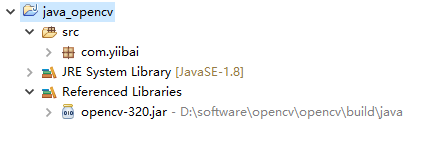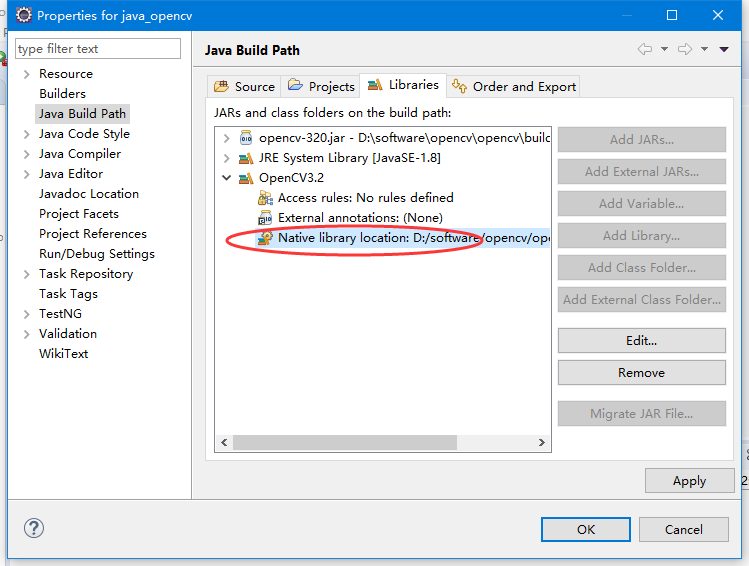在Java语言编程中,如何使用java启用电脑的摄像头摄相拍照?
注意:需要访问网址:http://book2s.com/java/jar/o/opencv/download-opencv-3.2.0-0.html , 下载一个OpenCV软件包。这里下载最新版本:opencv-3.2.0-vc14.exe并解压此文件到D:\software\opencv目录中。
项目结构如下图所示 -

添加一个用户自定义库:OpenCV3.2,并指配置构建路径为:D:\software\opencv\opencv\build\java\x64,如下图所示 -

注:可参考: http://blog.csdn.net/shawncheer/article/details/51098456
以下是使用Java从系统摄像头拍摄快照的程序 -
package com.zaixian;
import java.awt.image.BufferedImage;
import java.awt.image.DataBufferByte;
import java.awt.image.WritableRaster;
import java.io.FileNotFoundException;
import java.io.IOException;
import javafx.application.Application;
import javafx.embed.swing.SwingFXUtils;
import javafx.scene.Group;
import javafx.scene.Scene;
import javafx.scene.image.ImageView;
import javafx.scene.image.WritableImage;
import javafx.stage.Stage;
import org.opencv.core.Core;
import org.opencv.core.Mat;
import org.opencv.videoio.VideoCapture;
public class TakingSnapshotUsingCamera extends Application {
Mat matrix = null;
@Override
public void start(Stage stage) throws FileNotFoundException, IOException {
// Capturing the snapshot from the camera
TakingSnapshotUsingCamera obj = new TakingSnapshotUsingCamera();
WritableImage writableImage = obj.capureSnapShot();
// Setting the image view
ImageView imageView = new ImageView(writableImage);
// setting the fit height and width of the image view
imageView.setFitHeight(400);
imageView.setFitWidth(600);
// Setting the preserve ratio of the image view
imageView.setPreserveRatio(true);
// Creating a Group object
Group root = new Group(imageView);
// Creating a scene object
Scene scene = new Scene(root, 600, 400);
// Setting title to the Stage
stage.setTitle("启用摄向头照像");
// Adding scene to the satge
stage.setScene(scene);
// Displaying the contents of the stage
stage.show();
}
public WritableImage capureSnapShot() {
WritableImage WritableImage = null;
// Loading the OpenCV core library
System.loadLibrary(Core.NATIVE_LIBRARY_NAME);
// Instantiating the VideoCapture class (camera:: 0)
VideoCapture capture = new VideoCapture(0);
// Reading the next video frame from the camera
Mat matrix = new Mat();
capture.read(matrix);
// If camera is opened
if (capture.isOpened()) {
// If there is next video frame
if (capture.read(matrix)) {
// Creating BuffredImage from the matrix
BufferedImage image = new BufferedImage(matrix.width(), matrix.height(), BufferedImage.TYPE_3BYTE_BGR);
WritableRaster raster = image.getRaster();
DataBufferByte dataBuffer = (DataBufferByte) raster.getDataBuffer();
byte[] data = dataBuffer.getData();
matrix.get(0, 0, data);
this.matrix = matrix;
// Creating the Writable Image
WritableImage = SwingFXUtils.toFXImage(image, null);
}
}
return WritableImage;
}
public static void main(String args[]) {
launch(args);
}
}
在执行上面示例代码成功后,应该会看到如下输出 -

问题
F:\worksp\javaexamples\java_opencv
Exception in thread "main" java.lang.UnsatisfiedLinkError: no opencv_java320 in java.library.path
at java.lang.ClassLoader.loadLibrary(Unknown Source)
at java.lang.Runtime.loadLibrary0(Unknown Source)
at java.lang.System.loadLibrary(Unknown Source)
at com.zaixian.CopyAndPasteAnImage.main(CopyAndPasteAnImage.java:13)
解决上述问题可通过参考: http://blog.csdn.net/shawncheer/article/details/51098456
上一篇:
Java OpenCV
下一篇:
Apache Tika示例
